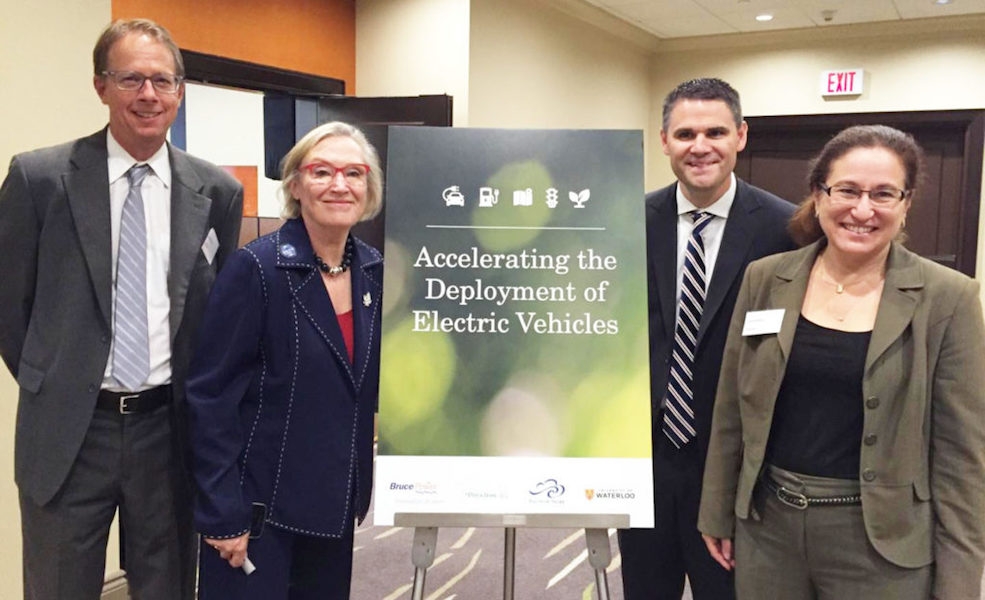
Electrified Transport
News
News
Canada is an “optimal country” for electric vehicle adoption
September 20, 2016 | By Anthony Capkun
 (Left to right): Steve McCauley, Pollution Probe; Carolyn Bennett, Federal Minister of Indigenous & Northern Affairs; James Scongack, Bruce Power; Cara Clairman, Plug’n Drive. Courtesy Bruce Power.
(Left to right): Steve McCauley, Pollution Probe; Carolyn Bennett, Federal Minister of Indigenous & Northern Affairs; James Scongack, Bruce Power; Cara Clairman, Plug’n Drive. Courtesy Bruce Power. September 20, 2016* – Electric vehicle (EV) technology presents an “enormous opportunity to help provinces and territories” reduce their greenhouse gas (GHG) emissions from the transportation sector, according to a collaborative report released by Bruce Power, Plug’n Drive, Pollution Probe and the University of Waterloo’s Dept. of Chemical Engineering.
Entitled “Accelerating the deployment of plug-in electric vehicles in Canada and Ontario,” the report also highlights opportunities to accelerate and optimize the decarbonization capability of EVs.
“Canada, as a whole, is blessed with a relatively low-carbon electricity mix, making it an optimal country to adopt EVs and realize deep decarbonization benefits,” said Bruce Power’s James Scongack. “Ontario, B.C. and Quebec are leading the way for EV adoption, and each has their own specific approach but, as outlined in the report, each strategy should consider electricity supply mix, distribution, demand and grid stability, public charging infrastructure, retail experience, public awareness and government coordination.”
Some of the report’s key recommendations include:
• Ensuring provincial governments maintain and, where applicable, improve their lower-carbon energy supply mix of nuclear, hydroelectric, renewables and natural gas to support EV adoption.
• The federal government should work with provinces and territories to develop individual clean transportation plans that account for energy supply mix. Those locations with more carbon-intensive supply mixes should be encouraged to create a strategy that balances emissions reductions realized from EVs and those from the electricity sector.
• Future EV infrastructure incentives should be reduced to partially government funded to encourage partnerships with the private sector.
• Assigning a lead ministry or agency within provincial governments with a mandate to implement Ontario’s vision related to EV deployment.
• The federal government should consider a national study that evaluates the EV experience across Canada, and identifies opportunities and barriers to EV deployment.
• Automakers, dealerships, governments and non-governmental organizations should work together to explore options for increasing EV inventory at dealerships, and consider committing to a percentage of dealerships that will have cars at any time. Enhanced financial incentives and recognition for salespeople should also be considered.
• The federal government should formally commit to and deliver on converting a portion of its operational fleet to EVs to demonstrate their viability to Canadians.
“The technology of emissions-free vehicles is improving every year, and infrastructure upgrades are happening continuously across the province and nationally,” noted Pollution Probe’s Steve McCauley. “Driving an EV is no longer a novelty; it is a practical mode of transportation, with the benefit of generating no carbon emissions.”
PHOTO: (Left to right): Steve McCauley, Pollution Probe; Carolyn Bennett, Federal Minister of Indigenous & Northern Affairs; James Scongack, Bruce Power; Cara Clairman, Plug’n Drive. Photo courtesy Bruce Power
* UPDATED September 23, 2016 with report (download PDF below), and group photo.
Print this page